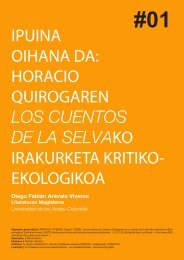03 - 452ºF
03 - 452ºF
03 - 452ºF
Create successful ePaper yourself
Turn your PDF publications into a flip-book with our unique Google optimized e-Paper software.
(Fanon, 1959).<br />
After years of negotiation and a number of dramatic events in<br />
Algeria and France—including a military coup in Algiers in 1958,<br />
the massacre of peaceful Algerian demonstrators in Paris in 1961,<br />
and amidst the terrorist activities of the pied noir militia, Secret<br />
Army Organization (OAS)—the Evian accords were signed on May<br />
19, 1962, effectively marking the end of a long and bitter war of<br />
independence. Following a referendum on July 1, 1962 the accords<br />
ratifying Algeria’s sovereignty were adopted by voters and France<br />
recognized the country’s autonomy on July 3, 1962. On the same<br />
day, the GPRA arrived in Algiers with its new leader, Ben Youssef<br />
Ben Khedda, who had recently replaced Ferhat Abbas, to a massive<br />
out-pouring of support and celebration in the streets of the capital.<br />
In regards to the massive number of European settlers, the GPRA<br />
stated that «the safety of those French people and of their possessions<br />
must be respected; their participation in the nation’s political life<br />
must be ensured on every level» (Stora, 2001: 125). Nonetheless,<br />
the majority of French settlers fled the country and went to France<br />
after independence. For many of them—who had lived in Algeria for<br />
generations—this was the first time they had set foot in France.<br />
In the summer of 1962 the struggle for power among different<br />
factions of the FLN and the ALN continued. Aggressive actions by<br />
the ALN inspired leaders of the nationalist movement to join forces<br />
to combat what was considered a military coup d’état; but the GPRA<br />
was eventually dissolved. This did not bring an immediate end to the<br />
fighting, however, and opposition movements continued in Kabylia<br />
and Algiers. With the bloody clash between Yacef Saadi’s commandos<br />
and guerrilla fighters on August 29th, the Algerian people marched in<br />
the streets calling out, «Seven years is enough!». On August 30, the<br />
ALN political bureau gave bureau troops permission to descend on<br />
Algiers, where violent skirmishes left more than a thousand people<br />
dead. Following this, executions and «purges» occurred including<br />
the massacre of several thousand harkis and the disappearance of<br />
over a thousand European settlers in the Oranie 2 . In September an<br />
agreement was finally reached which made Algiers a demilitarized<br />
zone and it was placed under the purview of the political bureau.<br />
Despite this agreement, Colonel Boumediene ordered the army<br />
to enter and occupy the capital. Following this, Ahmed Ben Bella<br />
was installed as the head of government. As sociologist Abdelkader<br />
Djeghloul notes: «This Algeria hardly resembles the one the first<br />
combatants of November 1954 dreamed of, who, for the most part,<br />
are absent from the country’s leadership» (Djeghloul, 1990: 777; my<br />
translation).<br />
NOTES<br />
2 | Harkis were Pro-French<br />
Algerian Muslims who fought<br />
on the side of France during<br />
the Revolution. The term<br />
«harkis» is derived from the<br />
Arabic word «harka» which<br />
means «movement».<br />
«Je suis un cowboy du Far West»: A study of textual métissage in Djanet Lachmet’s autobiographical novel Le Cow-boy (1983) - Caroline Kelley<br />
<strong>452ºF</strong>. #<strong>03</strong> (2010) 85-101.<br />
89










